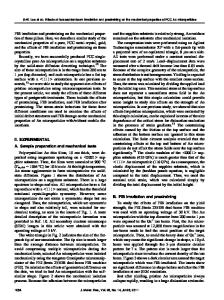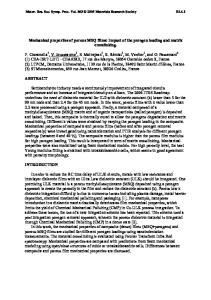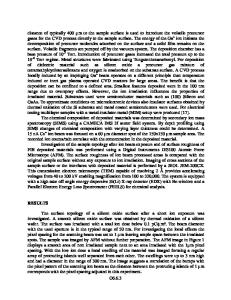Ion Irradiation Induced Crosslinking Effects on Mechanical Properties of Photoresist Films
- PDF / 377,018 Bytes
- 6 Pages / 420.48 x 639 pts Page_size
- 60 Downloads / 352 Views
289 Mat. Res. Soc. Symp. Proc. Vol. 585 © 2000 Materials Research Society
EXPERIMENTAL PART The AZ 1350 jTM photoresist, supplied by Shipley Europe Ltd., is composed of 70% in weight of o-novolak and 30% in weight of diazonaphtoquinone. The films were obtained by spin coating on clean silicon 20 f)cm wafers and subsequent heating at 95°C for 25 min. to eliminate the solvent. The thickness of the films is around 1.7 pm and the density and the atomic percent composition of the pristine samples are respectively 1.3 g.cma and C46.13 H44. 86O7 .47N1 .06 S0 .44. The samples were irradiated with 380 keV He ions in a range of fluences from 1013 to 1016 cm -2. The stopping powers of the ion in the photoresist and the projected range were calculated by using the TRIM code [7]. The parameters of the irradiation are shown in Table I. The average electronic (Se) and nuclear (SJ)stopping powers are 19 and 0.3 eV.A-1 respectively and the projected range of the ion is 2.05 Itm. The average total deposited energy density, is: (Pt) = tb(Se + Sn ), where 0b is the fluence of irradiadion. The energy of the beam was sufficient
to allow the He ions to pass through all the film thickness. The irradiation beam current densities were lower than 50 nA.cm-2 to avoid heating of the material. Table I - Fluences and average deposited energy densities for the AZ 1350 jTM films irradiated with 380 keV He ions.
S (He .cm-2) 1 x 1013 I x l0o4 3 x 1014 1 x lol5 5 x 10"5 I x lO6
(eV.- 3 ) 0.02 0.19 0.56 1.9 9.3 19
(eV.- 3 ) 3.0 x 10-4 3.0x 10-3 9.0 x 10-3 3.0 x 10-2 15 x 10-2 3.0 x 10-'
(eV.A-3) 0.02 0.20 0.57 1.9 9.5 19
The hardness (H) and the Young's modulus (E) of the films were obtained by using the technique described by Oliver and Pharr [8] through the analysis of loading-unloading curves in a Nanoindenter Iff' machine at the Departamento de Fisica, UFPR. The loading-unloading curves were measured by varying the load until a predefined depth of penetration was attained. In this experiment the depths of penetration varied from 50 up to 600 nm in order to check the homogeneity of H and E in this range of penetration. The maximum depth of penetration reached about 35% of the film thickness. Raman spectra were obtained using a HeNe laser of 10 mW for excitation with k= 632.9 nm. The microbeam of about 2 ptm was moved rapidly in a random pattern over the samples to avoid local heating and photodamage of the film by the laser light. The density of the pristine and irradiated photoresist films were determined through weight and volume measurements. A microbalance model ATI CAHN C-35C (0.11tg) was used in the weight determinations. The weight of the photoresist film was obtained subtracting the weight of the substrate plus film from the weigh of the substrate after the removal of the film by oxidation. The volume was calculated using the area and the thickness of the film. The thickness of the films was obtained from the interference pattern of the FTIR spectra, using the procedure described in reference [9]. The gel content was determ
Data Loading...











